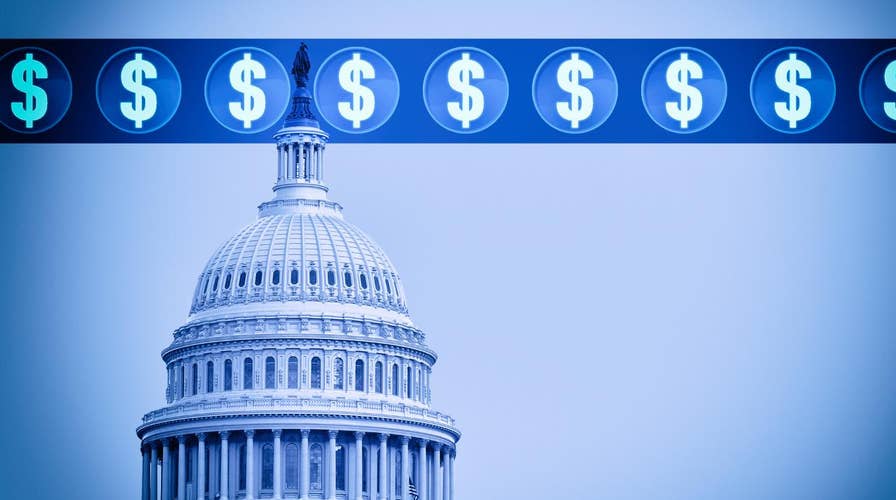Why the American welfare state is unsustainable
Expanding entitlement costs are a grave threat to growing debt; Doug McKelway takes a closer look for 'Special Report'
The Trump economy is strong. The stock market is at record highs and the unemployment rate is at a 17-year low. This is thanks largely to the Trump Administration’s aggressive regulatory reforms and the passage of historic tax cuts. Business after business is celebrating the passage of Tax Cuts and Jobs Act by announcing new investments, bonuses, and pay raises.
But despite soaring business confidence and a strong economy, businesses are scrambling to find workers to fill 6 million open jobs. And now, their primary challenge is to get people who have been sitting on the sidelines back to work.
President Trump knows our broken welfare system is a major barrier to achieving this goal, and he has vowed to tackle welfare reform next. And it’s a good thing, because welfare definitely is, as the President put it, “out of control.”
In 2000, over 17 million Americans received food stamps, officially known as Supplemental Nutrition Assistance Program (SNAP) benefits. That number has swelled to more than 42 million today. As a result of Obama Administration’s policies, the number of Americans on food stamps is now greater than the population of Canada.
Nationwide spending on the program is roughly $70 billion annually —20 percent of which is wasted on junk food, candy, soda, and other sugary drinks. Consider California, which spent more than $1 billion on food stamp benefits in August and September alone.
Nationwide spending on the program is roughly $70 billion annually —20 percent of which is wasted on junk food, candy, soda, and other sugary drinks. Consider California, which spent more than $1 billion on food stamp benefits in August and September alone.
During the Obama years, liberals argued that the program was expanding rapidly due to the recession. But that was only half the story, as the Obama Administration also expanded program eligibility through aggressive administrative actions.
And now, despite the booming economy and employers who are desperate for more workers, enrollment in food stamps remains high — and is not expected to return to pre-recession levels any time soon, if ever.
The good news is that President Trump has a chance to take on food stamps in the upcoming Farm Bill, which funds the program and is reauthorized every five years. The bad news is that unfortunately, the food stamp program is not the only runaway welfare program.
Medicaid enrollment has soared to nearly 75 million, with almost one out of every five Americans on the program. Medicaid spending is now 30 percent of state budgets, and the number of working age, able-bodied adults on the program has more than quadrupled since 2000. Even worse, 52 percent of non-disabled adult enrollees do not work at all. Let me repeat, these are able-bodied Americans who have decided not to work.
Similarly, Social Security Disability for working-age adults nearly doubled from 1996 to 2015, increasing from 7.7 million to 13 million and pulling more working-age adults out of the workforce. Are we to believe, with all of our workplace safety and health care advancements in the past 20 years, that Americans are now nearly twice as likely to become disabled as they were two decades ago? Or are there simply now more people collecting disability who are actually fully capable of working?
This is why President Trump’s plan to tackle welfare reform is so important. With no major federal welfare reform in over 20 years, these programs have continued to consume more public funds and encourage more Americans to seek dependency, rather than a productive work life.
When we worked with President Clinton to pass welfare reform in 1996, it helped drive the boom of the late 1990s. The welfare rolls shrunk by 60 percent nationwide and low-income families formerly on welfare went to work and saw their incomes increase by 25 percent. As a result, child poverty rates fell every year through 2000. In fact, it was the largest improvement in children leaving poverty in American history.
To do this again, we must get people back to work. One of the reasons that Temporary Assistance for Needy Families (TANF) cash welfare dependency hasn’t grown out of control, while enrollment in other welfare programs has dramatically increased, is that TANF has a work requirement and a time limit. Conversely, the food stamp program has a work requirement for only a narrow segment of adults and has been largely waived, and Medicaid has none at all, although states are now asking that it be added. The Trump Administration’s budget wisely proposes applying work requirements more broadly in the welfare system.
It’s smart because work requirements help lift people out of poverty. Maine and Kansas have shown that work requirements in TANF and food stamps helped people more than double their earnings.
The President should take an all-of-the-above approach to welfare reform. He should pull back on some of the Obama Administration's overreaches, approve waiver requests, advocate for Congress to reform food stamps in the upcoming Farm Bill, and work with Congress on additional legislation.
Now is not the time for structural entitlement reform of Social Security or Medicare, but there is no better time economically and politically to tackle welfare reform and enable millions of Americans to experience the power of work. There is no more powerful economic force than an American experiencing the dignity of work and pride in a paycheck, earning the admiration of their children and the respect of their community. Let’s unleash it.

